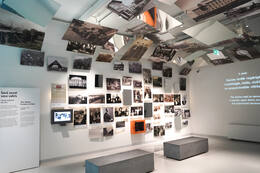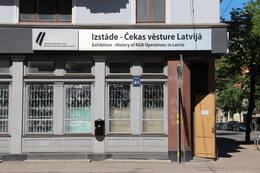Disidentas SSRS okupacijos metu
IV Sovietų okupacija
Disidentas (lot. dissidens – atskalūnas, pasisakantis prieš) plačiąja prasme yra asmuo, laikantis kitokių, priešingų pažiūrų nei esama valdžia ar visuomenės dauguma. Iš pradžių šis žodis reiškė žmones, nepriklausiusius šalyje dominuojančiai religijai ar konfesijai.
Septintajame dešimtmetyje Vakarų šalys disidentus Sovietų Sąjungoje ir kitose komunistinėse šalyse pradėjo vadinti opozicijos atstovais. Šis naujas opozicinis judėjimas atsirado SSRS lyderio N. Chruščiovo „atlydžio“ laikotarpiu. Disidentai skyrėsi nuo kitų opozicinių judėjimų tuo, kad naudojo nesmurtinius kovos metodus. Disidentai apeliavo į universalias vertybes, taip pat į teises, kurios buvo įrašytos sovietiniuose įstatymuose, bet nebuvo gerbiamos. Žmonės buvo persekiojami ir represuojami už disidentus, dažnai kalinami psichiatrijos ligoninėse kaip „psichikos ligoniai“. Žymūs sovietų disidentai buvo rašytojas Aleksandras Solženicynas, fizikas Andrejus Sacharovas ir kiti.
Žymiausi Latvijos disidentai Latvijos okupacijos metais buvo Gunārs Astra, Ints Cālītis, Eduards Berklavs, Lidija Doroņina-Lasmane, vadinamoji „Prancūzų grupė“, Knuts Skujenieks, Jurģis Skulme ir kt.
Daugiau informacijos šaltinių
Kategorija: Disidentai. Vikipedija. https://lv.wikipedia.org/wiki/Kategorija:Disidentai
Eduardas Berklavsas. Žinoti ir nepamiršti. http://www.eraksti.lv/autori/eduards_berklavs.html
Biruta Eglītė. Kas tu buvai, Gunārs Astra? Ryga, 1998 m.
Andris Grūtups. Stebėtojas. Dailininko Jurgio Skulmės teisme. Ryga, 2009 m.
Knuts Skujenieks, Bruno Javoišs. Kortelės. Virtuali kelionė spygliuota viela. Ryga, 2013 m.
Vilis Seleckis. Disidentas. Into Cālīčio gyvenimo istorija. Ryga, 2020 m.
Susijusios vietos
Latvijos okupacijos muziejus
Muziejuje eksponuojama Latvijos istorija nuo 1940 iki 1991 m., nacistinės Vokietijos ir Sovietų Sąjungos okupacijos laikotarpiu. „Ateities namai“ – tai žinomo Amerikos latvių architekto Gunāro Birkertaus suprojektuoto Okupacijos muziejaus rekonstrukcijos ir išplėtimo projektas, taip pat nauja muziejaus ekspozicija. Ekspoziciją „Čekos istorija Latvijoje“ sukūrė Okupacijos muziejus, ji yra buvusiame SSRS Valstybės saugumo komiteto (KGB) pastate „Kampiniame name“. Latvijos okupacijos muziejus buvo įkurtas 1993 m. Jis pasakoja ilgai slėptą Latvijos valstybės, tautos ir žemės likimo istoriją dviejų užsienio totalitarinių valstybių okupacijos laikotarpiu nuo 1940 iki 1991 m. 2020 m. pabaigoje muziejuje buvo daugiau nei 70 000 įvairių istorinių eksponatų (dokumentų, nuotraukų, rašytinių, žodinių ir daiktinių įrodymų, daiktų ir atminimo dovanų). Muziejaus specialistai įrašė daugiau nei 2400 vaizdo įrašų, todėl tai viena didžiausių okupacijos kolekcijų Europoje. Latvijoje, Lietuvoje ir Estijoje klostęsi įvykiai aiškiai parodo, ką tautoms teko ištverti valdant dviem totalitariniams režimams.
Paroda KGB pastate „KGB operacijų Latvijoje istorija“
Buvęs SSRS Valstybės saugumo komiteto (paprastai vadinamas Čeka) pastatas atviras lankytojams. Čia čekistai kalindavo, tardydavo ir žudydavo Latvijos piliečius, kuriuos okupacinis režimas laikė priešininkais. Taip pat eksponuojama Latvijos okupacijos muziejaus ekspozicija apie Čekos veiklą Latvijoje. Siūlomos ekskursijos po kalėjimo kameras, koridorius, rūsį ir kiemą. Namas pastatytas 1911 m. ir yra vienas gražiausių pastatų Rygoje. Liaudyje vadinamas „Kampiniu namu“, jis buvo baisiausias sovietinio okupacinio režimo simbolis Latvijoje ir vienas iš SSRS valdžios ramsčių. Čeka iš Kampinio namo veikė okupacijos metu nuo 1940 iki 1941 m., o vėliau nuo 1945 iki 1991 m. Dešimtys tūkstančių latvių nukentėjo nuo tiesioginio politinio persekiojimo. Kova su sovietų valdžios priešais tęsėsi ir po Antrojo pasaulinio karo. Čekos požiūris į savo veiklą šiek tiek pasikeitė po Stalino mirties. Fizinį kankinimą pakeitė psichologinis teroras. Dauguma Čekos agentų buvo latviai (52 %). Antra pagal dydį grupė buvo rusai – 23,7 %. 60,3 % agentų nebuvo Komunistų partijos nariai. 26,9 % agentų turėjo aukštąjį išsilavinimą. Sistema buvo sukurta taip, kad įtrauktų vietos gyventojus ir taip turėtų didesnę kontrolę visuomenėje. Personalo dokumentai ir tarnybos įrašai yra Rusijoje. Ši medžiaga nebuvo prieinama Latvijos valdžios institucijoms ir tyrėjams.
Paroda KGB pastate „KGB operacijų Latvijoje istorija“
Buvęs SSRS Valstybės saugumo komiteto (paprastai vadinamas Čeka) pastatas atviras lankytojams. Čia čekistai kalindavo, tardydavo ir žudydavo Latvijos piliečius, kuriuos okupacinis režimas laikė priešininkais. Taip pat eksponuojama Latvijos okupacijos muziejaus ekspozicija apie Čekos veiklą Latvijoje. Siūlomos ekskursijos po kalėjimo kameras, koridorius, rūsį ir kiemą. Namas pastatytas 1911 m. ir yra vienas gražiausių pastatų Rygoje. Liaudyje vadinamas „Kampiniu namu“, jis buvo baisiausias sovietinio okupacinio režimo simbolis Latvijoje ir vienas iš SSRS valdžios ramsčių. Čeka iš Kampinio namo veikė okupacijos metu nuo 1940 iki 1941 m., o vėliau nuo 1945 iki 1991 m. Dešimtys tūkstančių latvių nukentėjo nuo tiesioginio politinio persekiojimo. Kova su sovietų valdžios priešais tęsėsi ir po Antrojo pasaulinio karo. Čekos požiūris į savo veiklą šiek tiek pasikeitė po Stalino mirties. Fizinį kankinimą pakeitė psichologinis teroras. Dauguma Čekos agentų buvo latviai (52 %). Antra pagal dydį grupė buvo rusai – 23,7 %. 60,3 % agentų nebuvo Komunistų partijos nariai. 26,9 % agentų turėjo aukštąjį išsilavinimą. Sistema buvo sukurta taip, kad įtrauktų vietos gyventojus ir taip turėtų didesnę kontrolę visuomenėje. Personalo dokumentai ir tarnybos įrašai yra Rusijoje. Ši medžiaga nebuvo prieinama Latvijos valdžios institucijoms ir tyrėjams.
Susijusi istorija
Apie generolą Karlį Goppersą
Generolas K. Goppersas (1876–1941) buvo iškilus kareivis ir iškili asmenybė. Jis pasižymėjo kaip sėkmingas vadas, vadovavęs batalionams ir pulkams, didvyriškai vadovavęs savo šauliams kovose už Latvijos laisvę Pirmojo pasaulinio karo (1914–1919 m.) metu. Jis dalyvavo mūšiuose prie Tyreļpurvos, Ložmetējkalno ir ginant Rygą.
Regiono tyrėjas Žanis Skudra nuteistas 10 metų kalėjimo už „Okupuotos Latvijos dienoraštį“
Žanis Skudra visą laisvalaikį skiria vietos istorijai, visas atostogas – kelionėms po Latviją. Taip jis kaupė medžiagą, fotografavo ir sukūrė „Okupuotos Latvijos dienų knygą“, kurią leidžia Latvijos nacionalinis fondas Stokholme, pasivadinęs Jāniu Dzintarsu.
1978 m. birželio 7 d. Žani Skudra buvo suimtas Taline, o tų pačių metų lapkritį Rygos Aukščiausiasis Teismas jam skyrė dvylikos metų laisvės atėmimo bausmę už išdavystę ir šnipinėjimą.






